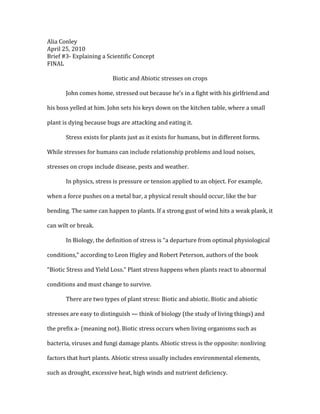
Conley Biotic&Abiotic Stress (Short Form)
- 1. Alia Conley<br />April 25, 2010<br />Brief #3- Explaining a Scientific Concept<br />FINAL<br />Biotic and Abiotic stresses on crops<br />John comes home, stressed out because he’s in a fight with his girlfriend and <br />his boss yelled at him. John sets his keys down on the kitchen table, where a small plant is dying because bugs are attacking and eating it.<br />Stress exists for plants just as it exists for humans, but in different forms. While stresses for humans can include relationship problems and loud noises, stresses on crops include disease, pests and weather. <br />In physics, stress is pressure or tension applied to an object. For example, when a force pushes on a metal bar, a physical result should occur, like the bar bending. The same can happen to plants. If a strong gust of wind hits a weak plank, it can wilt or break. <br />In Biology, the definition of stress is “a departure from optimal physiological conditions,” according to Leon Higley and Robert Peterson, authors of the book “Biotic Stress and Yield Loss.” Plant stress happens when plants react to abnormal conditions and must change to survive. <br />There are two types of plant stress: Biotic and abiotic. Biotic and abiotic stresses are easy to distinguish — think of biology (the study of living things) and the prefix a- (meaning not). Biotic stress occurs when living organisms such as bacteria, viruses and fungi damage plants. Abiotic stress is the opposite: nonliving factors that hurt plants. Abiotic stress usually includes environmental elements, such as drought, excessive heat, high winds and nutrient deficiency. <br />For plants like sorghum, biotic stress includes insect pests and diseases; abiotic stress is drought, said Gary Peterson, an INTSORMIL scientist and professor of grain-sorghum breeding at Texas A & M University. <br />For INTSORMIL scientists, understanding how these stresses affect plants is essential in order to research ways to prevent stress. Scientists are breeding sorghum and millet with better resistance1 to stresses like Striga and drought — this is the focus of six INTSORMIL project reports. If scientists can create top-notch plants, this can decrease the chance of biotic and abiotic stressors killing the plants. Humans know how to relieve stress, and now, humans are finding ways to help plants de-stress.<br />1See brief on resistance – page XX<br />Source list: <br />“Biotic Stress and Yield Loss” by Robert Peterson and Leon Higley (book)<br />